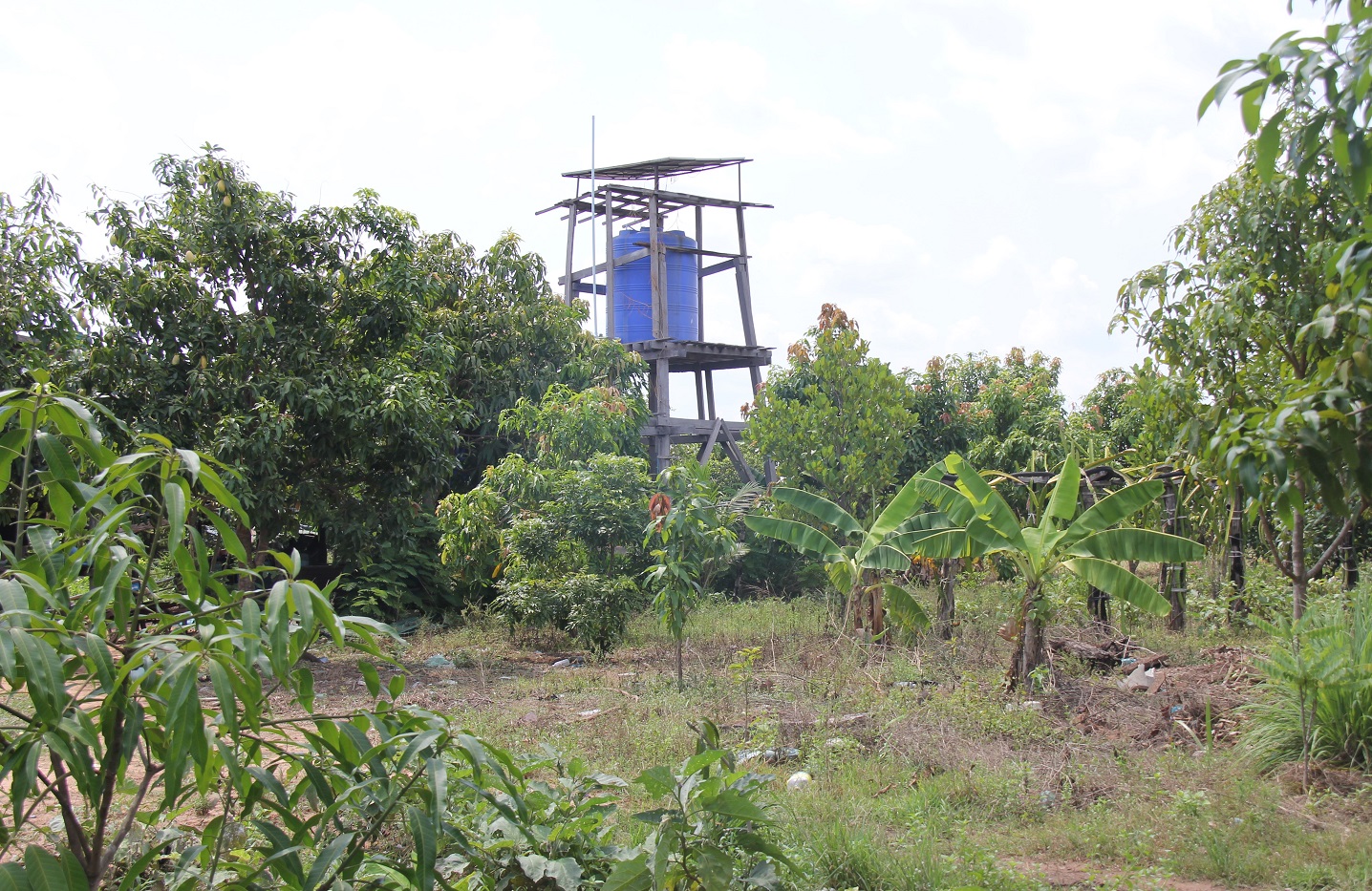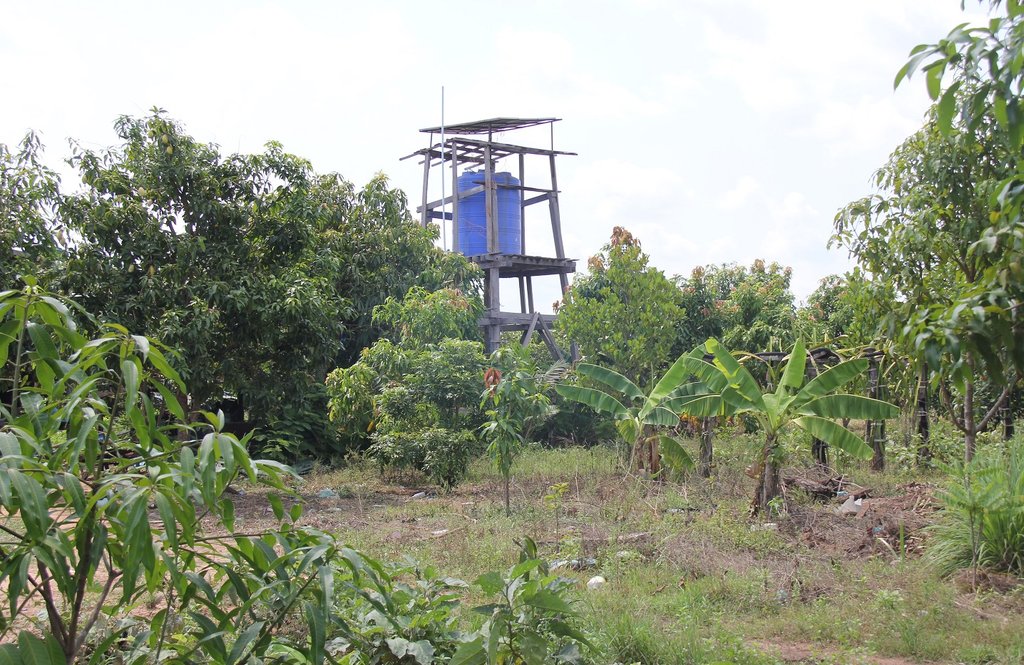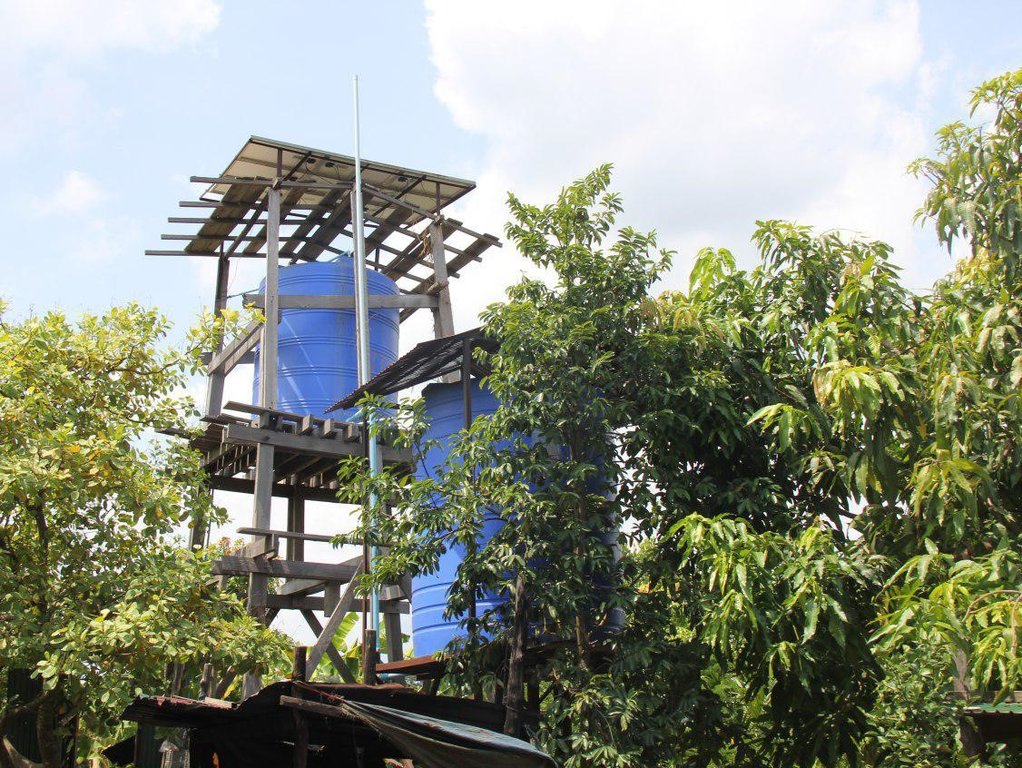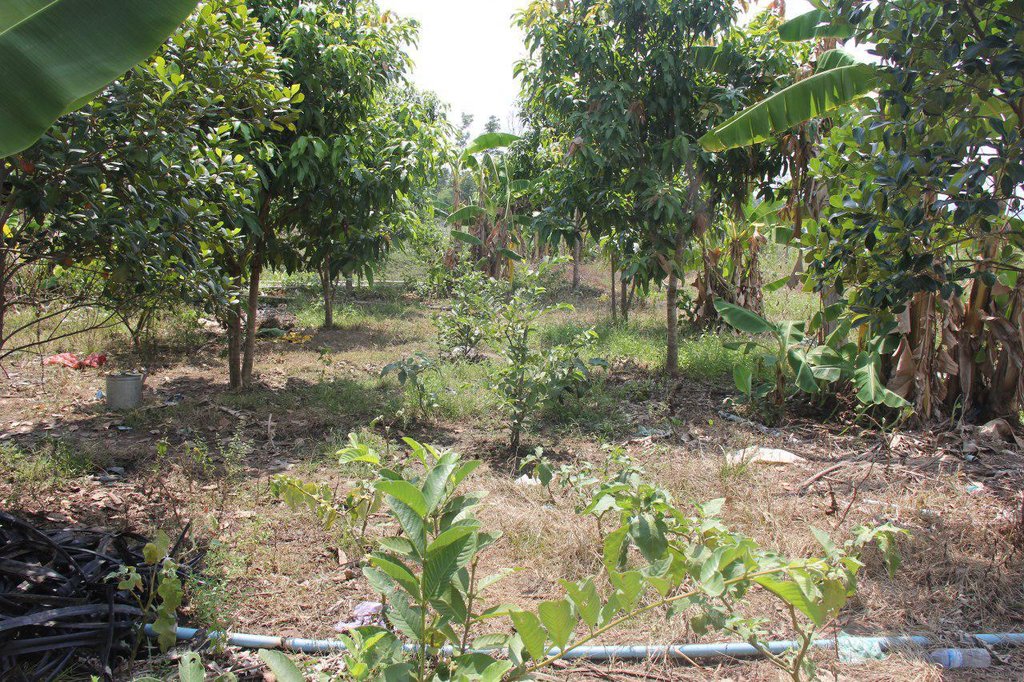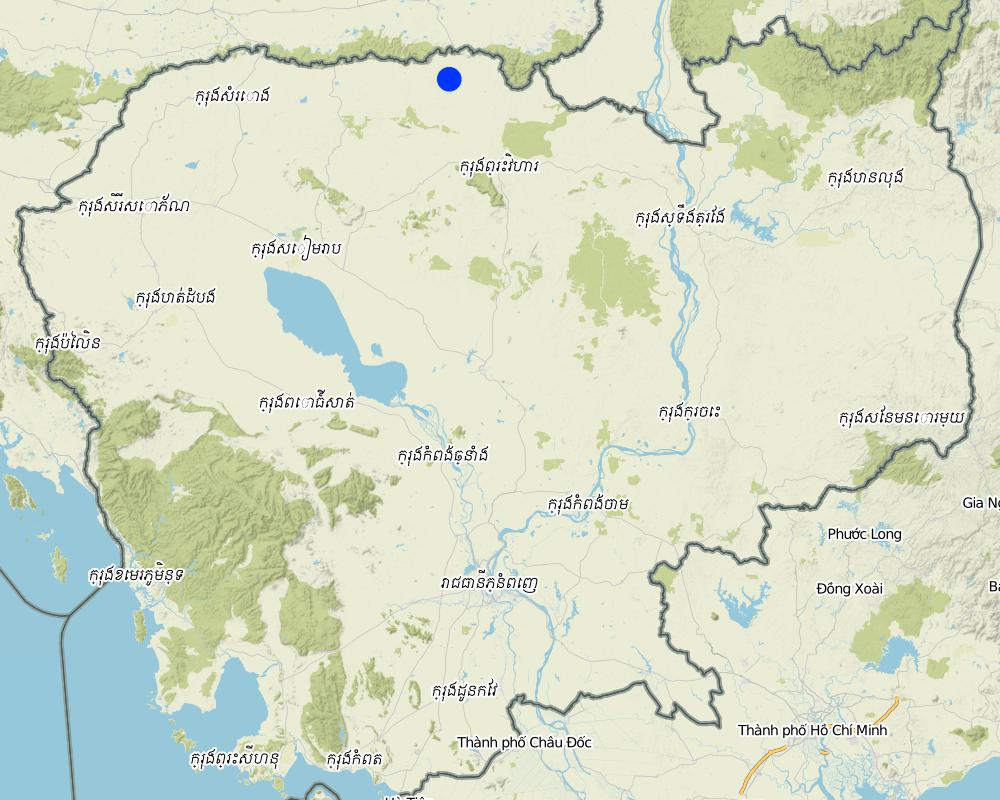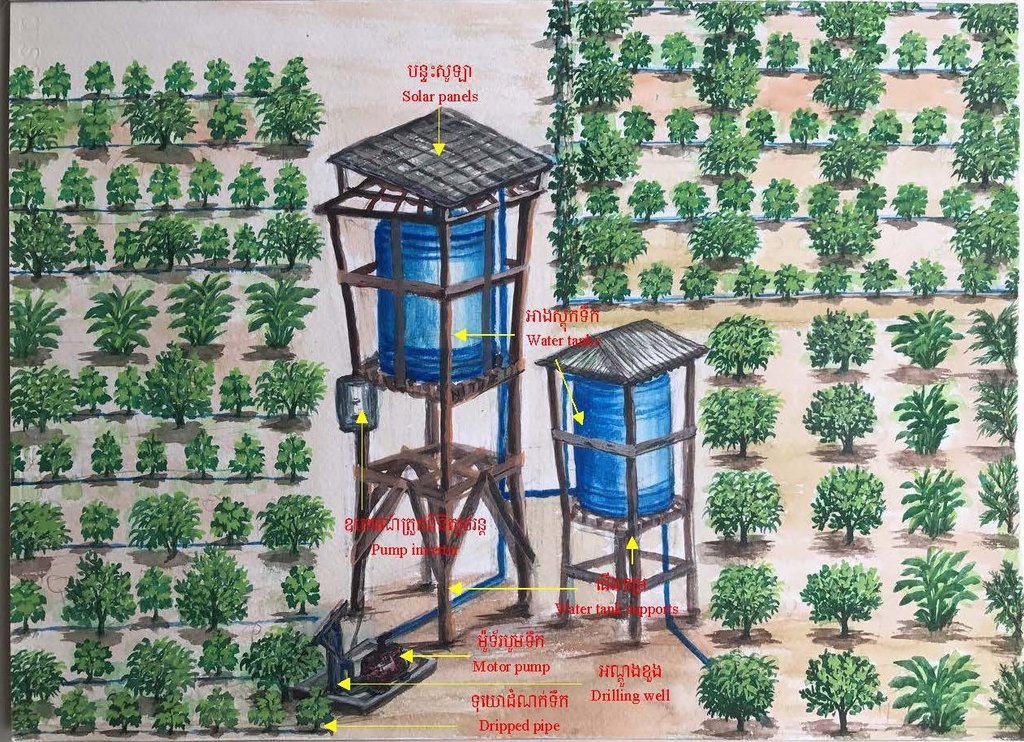Use of solar water pumping to adapt to climate change [Cambodia]
- Creation:
- Update:
- Compiler: Sok Pheak
- Editors: Sophea Tim, Navin Chea
- Reviewers: Nimul CHUN, Ursula Gaemperli, Alexandra Gavilano
Solar water pumping system
technologies_3214 - Cambodia
View sections
Expand all Collapse all1. General information
1.2 Contact details of resource persons and institutions involved in the assessment and documentation of the Technology
Key resource person(s)
land user:
Mao Sarath
Farmer
Cambodia
Commune extension worker:
Thun Phearak
Commune extension worker
Cambodia
Official of District Office of Agriculture, Forestry and Fisheries of Choam Khsant:
Prach Chhlath
District Office of Agriculture, Forestry and Fisheries of Choam Khsant
Cambodia
Chief of Office of Agriculture, Forestry and Fisheries:
Chief of Office of Agriculture, Forestry and Fisheries of Rovieng:
Official of Provincial Department of Agriculture, Forestry and Fisheries of Preah Vihear:
Name of project which facilitated the documentation/ evaluation of the Technology (if relevant)
Scaling-up SLM practices by smallholder farmers (IFAD)Name of the institution(s) which facilitated the documentation/ evaluation of the Technology (if relevant)
Royal University of Agriculture (RUA) - Cambodia1.3 Conditions regarding the use of data documented through WOCAT
The compiler and key resource person(s) accept the conditions regarding the use of data documented through WOCAT:
Yes
1.4 Declaration on sustainability of the described Technology
Is the Technology described here problematic with regard to land degradation, so that it cannot be declared a sustainable land management technology?
No
2. Description of the SLM Technology
2.1 Short description of the Technology
Definition of the Technology:
A solar water pump is a technology that uses solar panels to convert the solar power to electricity for pumping water from different sources including an underground source of water. The use of solar water pump is to reduces the operating costs, and avoid the CO2 emission, which is a good option for increasing climate resilience, and contributing to climate change mitigation.
2.2 Detailed description of the Technology
Description:
The solar water pump is an innovation that uses solar panels to convert the solar power to electricity for pumping water. It is an optimum choice to help reduce the impacts of climate change. The farmers in Thomacheat Samdach Te Chhor Hun Sen, Sror Aem Commune, Choam Ksant District, Preah Vihear Province, Cambodia previously used the water from ponds for the irrigation of their fields. But this supply was insufficient. In order to resolve the issue, the Cambodia Center for Study and Development in Agriculture (CEDAC) implemented a project and provided a bore hole with a solar powered pump in the commune in 2011 so as to irrigate the crops. In 2014, the Provincial Department of Agriculture, Forestry and Fishery (PDAFF under the support of the National Adaptation Programme of Action (NAPA Follow up phase 2) gave a set of solar water pump which was implemented in the commune for irrigating also the vegetable fields. They offered the village seven solar water pumps in total. One solar water pump has been installed at the house of Mr. Mao Sarath. The solar panels are portable, as sometime the solar power is variable.
The solar pump system consists of solar panels mounted on the top of a wooden structure, a pump motor, a pump inverter, a water storage tank with a supporting structure and electric cables. For its installation, a bore hole firstly needs to be drilled, and a pump needs to be put in place to draw the water from the bore hole and a for water delivery a drip pipe set has to be putted on the vegetable field. Then the supporting structures for two water storage tanks need to be installed which one of 4.8 and one of 2.04 meters in height. After the water storage tanks have been connected with a pump motor. Nine solar panels were fastened on the top of the water tank support construction and a pump inverter has been attached to generate electricity. The water in the tank has to be monitored regularly to secure permanent supply of water. The two water storage tanks have a capacity of 5000 liters which is enough for irrigating the crops and for the consumption of 3 households. Due to this kind of water supply facility the resilience to climate change has been increased and in consequence the emigration has been reduced. More people turned back to the agricultural sector, including farming.
The advantages of the technique are that water can be pumped automatically, that it saves labor and time, it does not use fuel, it reduces the CO2 emission, and it can deliver water at a considerable distance. A budget of 2000 USD was left to maintain the solar water pumps before the project has been completed. This budget was managed by the Border Development and Natural Agriculture Community; however, the community could use this budget for example for their members to take out a loan with an interest rate of 2% per month. After one year of the installation of the water pump, Mr. Mao Sarath expected to sell drinking water to other villagers during dry season or drought condition at cost of 1,500 Riel per cubic meter (excluded the 3 mentioned household). But until now, he was not able to do so due to the fact that other villagers were able to get access to bore holes with pumps and ponds by support of other NGOs too.
In short, the solar water pump is an innovation which uses solar energy to power a motor, thereby replacing a fuel powered motor which would have heavy impacts on the environment. The water is used to irrigate crops in the fields as well as for household consumption by the inhabitants of the village. This is to replace the bore holes with pumps in all of the different households, as villagers are now able to just drill one and install a solar powered pump with water storage tanks, and drip irrigation which provides water more easily to each household in the village.
2.3 Photos of the Technology
2.5 Country/ region/ locations where the Technology has been applied and which are covered by this assessment
Country:
Cambodia
Region/ State/ Province:
Thomacheat Samdach Te Chhor Hun Sen, Sror Aem commune, Choam Ksant district, Preah Vihear province
Further specification of location:
Rural area
Specify the spread of the Technology:
- applied at specific points/ concentrated on a small area
Comments:
Without any assistance from NGOs, the farmers could not spend their own money to buy solar water pumping due to the high cost.
Map
×2.6 Date of implementation
Indicate year of implementation:
2012
2.7 Introduction of the Technology
Specify how the Technology was introduced:
- through projects/ external interventions
Comments (type of project, etc.):
National Adaptation Programme of Action (NAPA Follow up phase 2).
3. Classification of the SLM Technology
3.1 Main purpose(s) of the Technology
- improve production
- reduce risk of disasters
- adapt to climate change/ extremes and its impacts
3.2 Current land use type(s) where the Technology is applied

Cropland
- Annual cropping
- Perennial (non-woody) cropping
- Tree and shrub cropping
- short-term cropping
Annual cropping - Specify crops:
- vegetables - melon, pumpkin, squash or gourd
- eggplant
Annual cropping system:
Vegetables - wheat/barley/oat/upland rice
Perennial (non-woody) cropping - Specify crops:
- flower crops - perennial
Tree and shrub cropping - Specify crops:
- fruits, other
- mango, mangosteen, guava
- jack fruit
Number of growing seasons per year:
- 3
Comments:
The farmer grew short-term crops such as mango, jack-fruit, eggplant, and luffa gourds.
3.3 Has land use changed due to the implementation of the Technology?
Comments:
Pond and pumping well
3.4 Water supply
Water supply for the land on which the Technology is applied:
- full irrigation
Comments:
Using solar water pumps and pond for irrigation .
3.5 SLM group to which the Technology belongs
- water harvesting
- irrigation management (incl. water supply, drainage)
- water diversion and drainage
3.6 SLM measures comprising the Technology

structural measures
- S7: Water harvesting/ supply/ irrigation equipment
- S10: Energy saving measures
3.7 Main types of land degradation addressed by the Technology

water degradation
- Ha: aridification
3.8 Prevention, reduction, or restoration of land degradation
Specify the goal of the Technology with regard to land degradation:
- prevent land degradation
- reduce land degradation
4. Technical specifications, implementation activities, inputs, and costs
4.1 Technical drawing of the Technology
Technical specifications (related to technical drawing):
The solar pump system consists of solar panels mounted on the top of a wooden structure, a pump motor, a pump inverter, and a water storage tanks with a supporting structure and electric cables. The bore hole has a depth of 29 meters and a diameter of 0.08 m . One water tank holding construction hasa height of 2.04 meters and the other has a height of 2.8 meter. The water tanks have a volume of 5000 liters. The solar water pump is able to draw 6-7 cubic meters per day and if there is full sun shine it can reach up to 8 cubic meters per day.
Author:
Mr. Khuon Sophal
Date:
06/05/2017
4.2 General information regarding the calculation of inputs and costs
Specify how costs and inputs were calculated:
- per Technology unit
Specify unit:
1 solar pump to keep two water tanks of 5000 litters filled up
Specify dimensions of unit (if relevant):
Tank volume is 5000 litter per tank
other/ national currency (specify):
Riel
If relevant, indicate exchange rate from USD to local currency (e.g. 1 USD = 79.9 Brazilian Real): 1 USD =:
4000.0
Indicate average wage cost of hired labour per day:
20000 Riel
4.3 Establishment activities
| Activity | Timing (season) | |
|---|---|---|
| 1. | Constructiong of pumping well | February |
| 2. | water tank support | May |
| 3. | Buying water tanks | May |
| 4. | Solar water pumping intallation | May |
| 5. | Pump monitor | May |
4.4 Costs and inputs needed for establishment
| Specify input | Unit | Quantity | Costs per Unit | Total costs per input | % of costs borne by land users | |
|---|---|---|---|---|---|---|
| Labour | Construction of pumping well | set | 1.0 | 1600000.0 | 1600000.0 | |
| Labour | Building a wooden structure | set | 1.0 | 800000.0 | 800000.0 | |
| Equipment | Water tanks | piece | 2.0 | 2000000.0 | 4000000.0 | |
| Equipment | Controller unit | set | 1.0 | 4000000.0 | 4000000.0 | |
| Equipment | Pump motor including the solar panels | set | 1.0 | 8000000.0 | 8000000.0 | |
| Construction material | water tank supports | Number | 2.0 | 800000.0 | 1600000.0 | 100.0 |
| Total costs for establishment of the Technology | 20000000.0 | |||||
| Total costs for establishment of the Technology in USD | 5000.0 | |||||
If land user bore less than 100% of costs, indicate who covered the remaining costs:
NAPA follow up project pays for solar water pumping and CEDAC pays for pumping well.
Comments:
The whole set of a solar water pump installation costs 5000 USD (=20,000,000 Riel)
4.5 Maintenance/ recurrent activities
| Activity | Timing/ frequency | |
|---|---|---|
| 1. | Checking the water levels and control of the installation | Dry season |
4.6 Costs and inputs needed for maintenance/ recurrent activities (per year)
| Specify input | Unit | Quantity | Costs per Unit | Total costs per input | % of costs borne by land users | |
|---|---|---|---|---|---|---|
| Labour | Repair work on the pump motor | number | 1.0 | 400000.0 | 400000.0 | 100.0 |
| Total costs for maintenance of the Technology | 400000.0 | |||||
| Total costs for maintenance of the Technology in USD | 100.0 | |||||
If land user bore less than 100% of costs, indicate who covered the remaining costs:
Paid by the National Adaptation Programme of Action (NAPA Follow up phase 2).
Comments:
The repairs to pump motor when needed for maintenance due to the project left USD 2000 for repair service.
4.7 Most important factors affecting the costs
Describe the most determinate factors affecting the costs:
The price of solar water pumping is expensive so that it affects the farmer's expenditure seriously.
5. Natural and human environment
5.1 Climate
Annual rainfall
- < 250 mm
- 251-500 mm
- 501-750 mm
- 751-1,000 mm
- 1,001-1,500 mm
- 1,501-2,000 mm
- 2,001-3,000 mm
- 3,001-4,000 mm
- > 4,000 mm
Specifications/ comments on rainfall:
In 2015, the annual rainfall was 1429.3 mm
In 2014, the annual rainfall was 1647.3 mm
Indicate the name of the reference meteorological station considered:
Ministry of Water Resource and Meteorology, 2015
Agro-climatic zone
- semi-arid
Monsoon with two main seasons - a dry and a rainy season.
5.2 Topography
Slopes on average:
- flat (0-2%)
- gentle (3-5%)
- moderate (6-10%)
- rolling (11-15%)
- hilly (16-30%)
- steep (31-60%)
- very steep (>60%)
Landforms:
- plateau/plains
- ridges
- mountain slopes
- hill slopes
- footslopes
- valley floors
Altitudinal zone:
- 0-100 m a.s.l.
- 101-500 m a.s.l.
- 501-1,000 m a.s.l.
- 1,001-1,500 m a.s.l.
- 1,501-2,000 m a.s.l.
- 2,001-2,500 m a.s.l.
- 2,501-3,000 m a.s.l.
- 3,001-4,000 m a.s.l.
- > 4,000 m a.s.l.
Indicate if the Technology is specifically applied in:
- not relevant
5.3 Soils
Soil depth on average:
- very shallow (0-20 cm)
- shallow (21-50 cm)
- moderately deep (51-80 cm)
- deep (81-120 cm)
- very deep (> 120 cm)
Soil texture (topsoil):
- medium (loamy, silty)
Soil texture (> 20 cm below surface):
- medium (loamy, silty)
Topsoil organic matter:
- high (>3%)
If available, attach full soil description or specify the available information, e.g. soil type, soil PH/ acidity, Cation Exchange Capacity, nitrogen, salinity etc.
Good soil fertility due to fact that the farmer uses cow manure on the crop fields.
5.4 Water availability and quality
Ground water table:
5-50 m
Availability of surface water:
medium
Water quality (untreated):
for agricultural use only (irrigation)
Is water salinity a problem?
No
Is flooding of the area occurring?
No
Comments and further specifications on water quality and quantity:
The water is calcareous and should be boiled before drinking; however, it does not affect the crops growth negatively.
5.5 Biodiversity
Species diversity:
- low
Habitat diversity:
- low
5.6 Characteristics of land users applying the Technology
Sedentary or nomadic:
- Sedentary
Market orientation of production system:
- mixed (subsistence/ commercial)
Off-farm income:
- less than 10% of all income
Relative level of wealth:
- average
Individuals or groups:
- individual/ household
Level of mechanization:
- manual work
- mechanized/ motorized
Gender:
- men
Age of land users:
- elderly
Indicate other relevant characteristics of the land users:
The farmer who implemented this technology is 60 years old, but he is still able to work in the field.
5.7 Average area of land used by land users applying the Technology
- < 0.5 ha
- 0.5-1 ha
- 1-2 ha
- 2-5 ha
- 5-15 ha
- 15-50 ha
- 50-100 ha
- 100-500 ha
- 500-1,000 ha
- 1,000-10,000 ha
- > 10,000 ha
Is this considered small-, medium- or large-scale (referring to local context)?
- small-scale
Comments:
The farmer has 1 ha of land for vegetable growing, and 1.50 ha as leased farmland, where he grosws corn and mung bean.
5.8 Land ownership, land use rights, and water use rights
Land ownership:
- individual, titled
Land use rights:
- leased
- individual
Water use rights:
- open access (unorganized)
5.9 Access to services and infrastructure
health:
- poor
- moderate
- good
education:
- poor
- moderate
- good
technical assistance:
- poor
- moderate
- good
employment (e.g. off-farm):
- poor
- moderate
- good
markets:
- poor
- moderate
- good
energy:
- poor
- moderate
- good
roads and transport:
- poor
- moderate
- good
drinking water and sanitation:
- poor
- moderate
- good
financial services:
- poor
- moderate
- good
6. Impacts and concluding statements
6.1 On-site impacts the Technology has shown
Socio-economic impacts
Production
crop production
Quantity before SLM:
30%
Quantity after SLM:
60%
Water availability and quality
drinking water availability
Comments/ specify:
The farmer was able to have better access to water for crop irrigation and animal raising.
drinking water quality
Comments/ specify:
The drinking water quality is sligthly increased, but the farmer is also able to boil the water before drinking.
irrigation water availability
Comments/ specify:
After the solar powered water pump installation, the farmer hase access to water forcrop irrigation during all seasonal growings.
irrigation water quality
Comments/ specify:
The irrigation water quality is enough good even if it is limy. It does not impact the plant growing.
demand for irrigation water
Quantity before SLM:
30%
Quantity after SLM:
60%
Income and costs
expenses on agricultural inputs
Comments/ specify:
The farmer did not spend much due to high support of the project .
farm income
Comments/ specify:
Before the farmer's income was low due to the fact that the vegetable harvest was low. Because of the drip irrigation system combined with the solar water pump, he was able to cultivate more crops and he gets higher yield.
workload
Comments/ specify:
Beside the growing of vegetable the farmer now has more free time due to the solar powered pump that supports him to irrigate the crops.
Socio-cultural impacts
land use/ water rights
Comments/ specify:
The farmer hashis own land for growing vegetable and he has free access to the water for irrigation.
SLM/ land degradation knowledge
Comments/ specify:
The farmer learned that this technology helps reducing the soil erosion due to the use of drip irrigation and also that solar powered pump contributes to environmental protection by not not using fuel for the pumping machine.
Ecological impacts
Water cycle/ runoff
water quantity
Comments/ specify:
As the solar water pump need solar energy to generate electricity, the amount of water to be pumped depends upon the available solar power.
Climate and disaster risk reduction
emission of carbon and greenhouse gases
Comments/ specify:
Due to solar panel driven water pump.
6.2 Off-site impacts the Technology has shown
impact of greenhouse gases
Comments/ specify:
Due to solar panels driven water pump for household consumption and irrigation.
Comments/ specify:
Water delivery to neighbors whenever there is not enough water during the drought period.
6.3 Exposure and sensitivity of the Technology to gradual climate change and climate-related extremes/ disasters (as perceived by land users)
Gradual climate change
Gradual climate change
| Season | increase or decrease | How does the Technology cope with it? | |
|---|---|---|---|
| annual temperature | decrease | moderately | |
| seasonal temperature | wet/ rainy season | increase | moderately |
| annual rainfall | decrease | well | |
| seasonal rainfall | wet/ rainy season | decrease | well |
Other climate-related consequences
Other climate-related consequences
| How does the Technology cope with it? | |
|---|---|
| extended growing period | well |
Comments:
In the upland area it is difficult to get access to water during the dry season, particularly when drought occurs. However, by this technology the farmer Mr. Mao Sarath was still able to extend the growing period and to get access to water for consumption and crop cultivation.
6.4 Cost-benefit analysis
How do the benefits compare with the establishment costs (from land users’ perspective)?
Short-term returns:
positive
Long-term returns:
very positive
How do the benefits compare with the maintenance/ recurrent costs (from land users' perspective)?
Short-term returns:
positive
Long-term returns:
very positive
6.5 Adoption of the Technology
- 1-10%
If available, quantify (no. of households and/ or area covered):
7 housholds of Thomacheat Samdach Te Chhor Hun Sen village implemented the technology (the one examined here included)
Of all those who have adopted the Technology, how many did so spontaneously, i.e. without receiving any material incentives/ payments?
- 0-10%
Comments:
Until now the households are not able to buy solar water pumps and to adopt this technology by themselves because it is very expensive, and due to fact that they were assisted substantially by the ministry, by relevant stakeholders or NGOs.
6.6 Adaptation
Has the Technology been modified recently to adapt to changing conditions?
No
6.7 Strengths/ advantages/ opportunities of the Technology
| Strengths/ advantages/ opportunities in the land user’s view |
|---|
| Water can be accessed to irrigate crops without the use of a fuel powered pump. |
| Economically beneficial as there is no need to buy diesel to pump water. |
| Strengths/ advantages/ opportunities in the compiler’s or other key resource person’s view |
|---|
| Adapting to the impacts of climate change. |
| Reducing GHG emissions into the atmosphere. |
6.8 Weaknesses/ disadvantages/ risks of the Technology and ways of overcoming them
| Weaknesses/ disadvantages/ risks in the land user’s view | How can they be overcome? |
|---|---|
| High expenditure. | Secure assistance from NGOs and other ways to jointly implement this technology. |
| Weaknesses/ disadvantages/ risks in the compiler’s or other key resource person’s view | How can they be overcome? |
|---|---|
| - |
7. References and links
7.1 Methods/ sources of information
- field visits, field surveys
3 persons
- interviews with land users
1 person
When were the data compiled (in the field)?
06/05/2017
7.2 References to available publications
Title, author, year, ISBN:
Abrams, J. H. (2015). Climate Resilient Irrigation Training Manual. Phnom Penh: Project Support Unit, Ministry of Agriculure, Forestry, and Fisheries (MAFF-PSU).
Available from where? Costs?
MAFF, Free available.
7.3 Links to relevant online information
Title/ description:
CDD. (2014). NAPA Follow-UP-Cambodia's Official Climate Change Website. Retrieved February 7, 2018, from
URL:
http://www.camclimate.org.kh/en/activities/napa-follow-up.html
Title/ description:
SGE. (2015). Soalr water pump with sun tracker. Retrieved February 7, 2018, from
URL:
http://www.solarcambodia.com/index.php?lang=en&p=products-system&id=10
Links and modules
Expand all Collapse allLinks
No links
Modules
No modules


